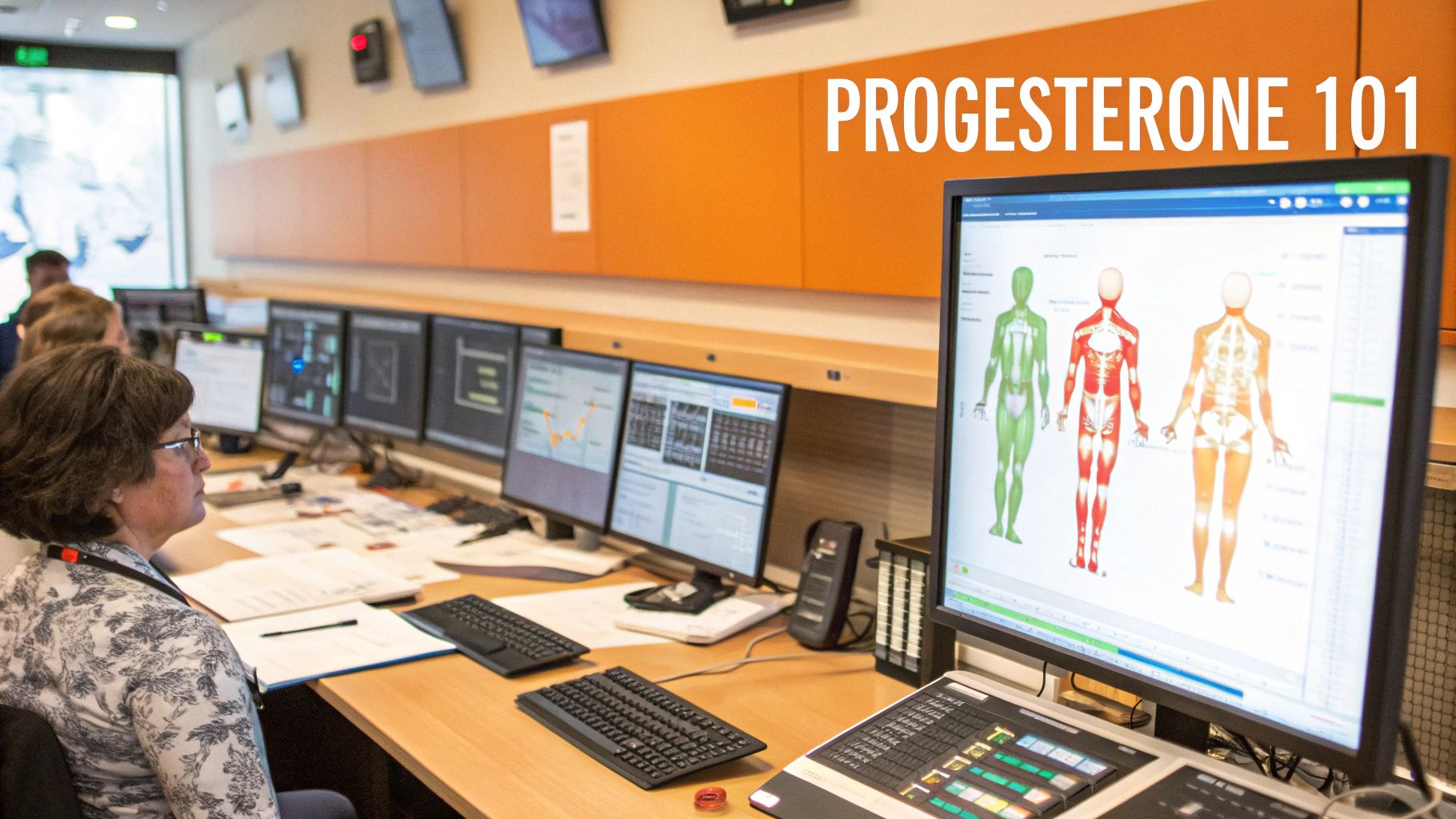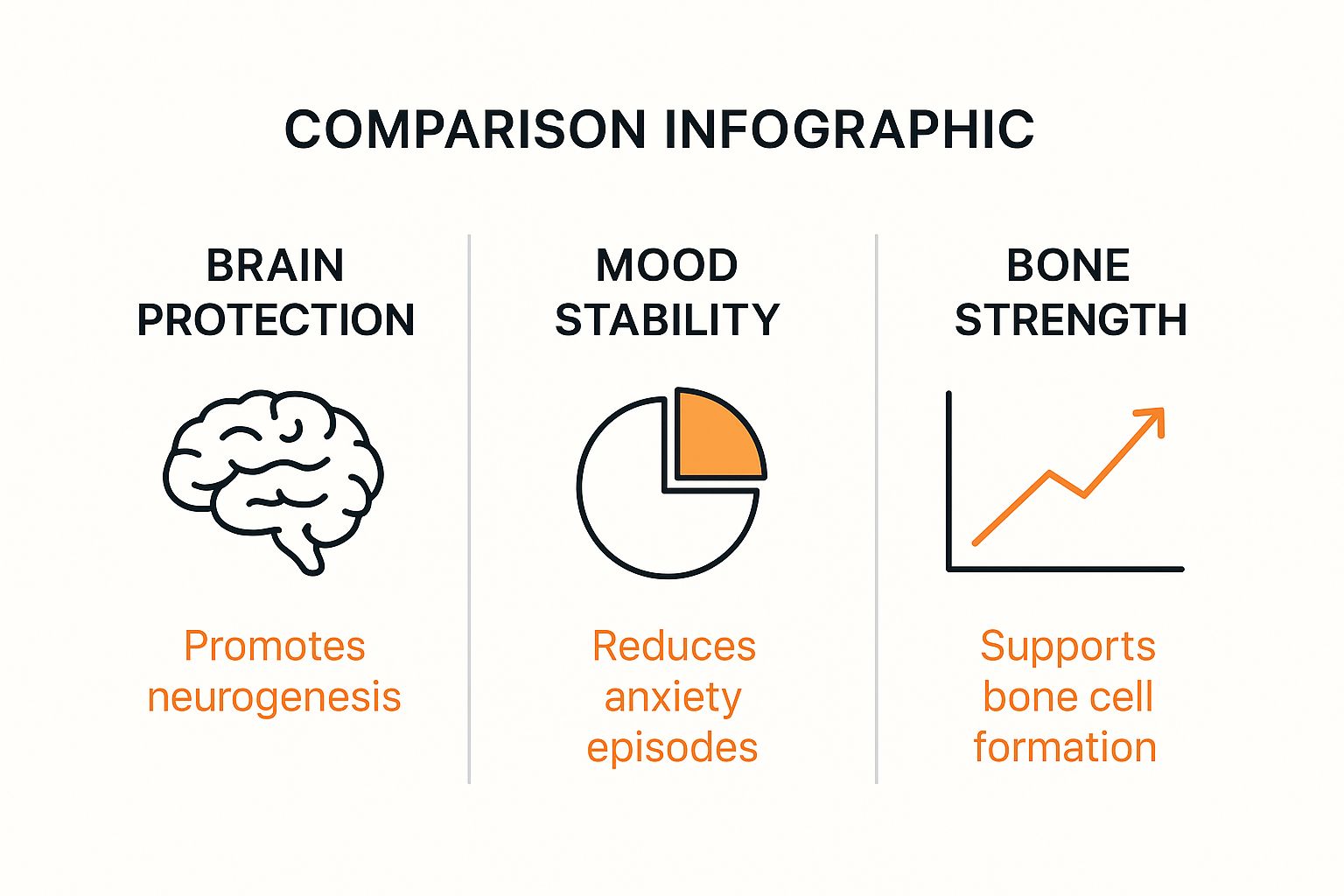The Essential Benefits of Progesterone for Women

From regulating your monthly cycle to supporting a healthy pregnancy, improving sleep, and even calming your mood, the benefits of progesterone are far-reaching. This essential hormone is a natural balancer, especially during the rollercoaster of perimenopause, making it a cornerstone of female wellness. Its soothing effect on the brain and protective role in the uterus show just how important it is far beyond reproduction alone.
What Is Progesterone and Why Does It Matter

Think of progesterone as your body’s master project manager. It’s the calm, steady force working behind the scenes to make sure big projects—like your menstrual cycle—run on schedule and that critical systems stay in balance. When it's not around, things can get chaotic pretty quickly, leading to symptoms that throw your daily life off track.
So, what exactly is this powerful hormone? Progesterone is a steroid hormone made mostly in the ovaries right after ovulation each month. Your adrenal glands also produce small amounts, and during pregnancy, the placenta becomes a major source. Its name even gives away its most famous job, coming from "pro-gestation," meaning "for pregnancy."
The Great Balancer
One of progesterone's most vital roles is to act as a counterbalance to estrogen. Picture estrogen as the energetic architect who spends the first half of your cycle building up the uterine lining. Progesterone is the calm inspector who comes in after ovulation to mature and stabilize that lining, making sure everything is just right.
This balancing act is crucial for a few key reasons:
- Menstrual Regularity: It makes sure the uterine lining sheds correctly if pregnancy doesn't happen, leading to a predictable period.
- Uterine Health: By keeping estrogen's growth in check, progesterone protects the uterine lining from getting too thick, which can be a risk factor for certain health issues.
- Mood Stability: Progesterone has a calming effect on the brain, acting a bit like a natural anti-anxiety agent that helps you relax and get better sleep.
Progesterone doesn't just manage projects; it creates a healthy work environment. Its influence on the nervous system helps reduce anxiety and improve sleep quality, making it a cornerstone of both physical and mental well-being.
Key Physiological Roles of Progesterone
To get a clear picture of just how versatile this hormone is, it helps to break down its main jobs across different areas of your health.
The table below summarizes progesterone's core functions with some simple analogies to make them easier to remember.
Progesterone At a Glance: Key Physiological Roles
| Area of Influence | Primary Role of Progesterone | Simplified Analogy |
|---|---|---|
| Reproductive Health | Prepares and maintains the uterine lining for pregnancy. | A gardener tending the soil for a seed. |
| Nervous System | Promotes calmness, reduces anxiety, and aids sleep. | A sound-dampening blanket for the mind. |
| Hormonal Balance | Counteracts the proliferative effects of estrogen. | A seesaw's weight, keeping things level. |
| Bone Health | Stimulates the activity of bone-building cells. | A construction crew for your skeleton. |
As you can see, progesterone's influence extends from reproductive health to your nervous system and even your bones. It’s a true multitasker, quietly ensuring that many of your body’s most important systems run smoothly.
Progesterone's Role in Fertility and Pregnancy

For anyone hoping to start or grow their family, progesterone is a hormone you need to know about. It acts as the master architect and guardian of pregnancy, playing a vital role from the moment of conception all the way through delivery. Without enough of it, getting and staying pregnant becomes incredibly difficult.
Think of the uterus as a garden bed being prepared for a precious seed. After ovulation, progesterone’s first job is to make this bed rich and welcoming. It signals the uterine lining, the endometrium, to thicken and fill with blood vessels, creating a nourishing home where a fertilized egg can implant and thrive.
This preparation phase is absolutely crucial. If progesterone levels are too low during this window, the lining won’t be receptive, and implantation can fail—often before a pregnancy is even detected.
The Guardian of Early Pregnancy
Once a fertilized egg has implanted, progesterone’s job shifts from preparation to protection. It becomes the primary hormone responsible for maintaining the pregnancy, which is how it earned its name as the "pro-gestation" hormone. It works around the clock to keep the uterine environment calm and supportive for the developing embryo.
Here are some of its most important protective jobs:
- Preventing Contractions: Progesterone keeps the powerful uterine muscles relaxed, preventing premature contractions that could threaten the pregnancy.
- Supporting Blood Flow: It ensures a steady supply of oxygen and nutrients can reach the growing fetus through a healthy placenta.
- Suppressing Immune Response: It gently quiets the mother's immune system to prevent it from seeing the fetus as a foreign intruder and rejecting it.
This hormonal support is so critical that the placenta takes over progesterone production around the tenth week of pregnancy. This ensures levels stay high enough to sustain the baby all the way to birth.
Progesterone doesn't just build the nursery; it stands guard at the door for nine months. Its calming influence on the uterus is the single most important factor in preventing early pregnancy loss and ensuring a stable environment for fetal development.
A Game-Changer for Preventing Miscarriage
The powerful benefits of progesterone aren't just theoretical. They’ve become a cornerstone of modern fertility treatment, offering real hope to many who have experienced recurrent pregnancy loss. Clinical research has solidified its effectiveness, especially for women with a history of miscarriage.
For instance, studies show that progesterone supplementation can significantly reduce miscarriage rates in women with unexplained recurrent losses. High-dose vaginal progesterone has proven especially helpful for women who experience bleeding in early pregnancy, leading to updated national medical guidelines in countries like the UK. It's now estimated that proper treatment could prevent thousands of pregnancy losses every year. To explore the full impact of these findings, you can learn more about the research on progesterone and miscarriage prevention.
From preparing the perfect environment for implantation to acting as a constant protector throughout gestation, the benefits of progesterone in fertility are undeniable. It is the quiet, consistent force that makes pregnancy possible and helps bring new life into the world safely.
Navigating Perimenopause with Progesterone

Perimenopause often feels like a hormonal rollercoaster, a chaotic transition that can leave you feeling exhausted, anxious, and completely overwhelmed. During this time, your estrogen levels can swing wildly up and down, but progesterone tends to take a steady dive. This growing gap between the two is what drives many of the most disruptive symptoms.
Think of your hormonal system as a finely tuned seesaw. On one side, you have estrogen with its stimulating, energizing effects. On the other, you have progesterone, the calming, balancing force. As progesterone levels fall, the seesaw becomes lopsided, leaving estrogen's effects to run wild without a counterbalance. This is the root cause of common struggles like terrible sleep, irritability, and unpredictable, heavy periods.
Restoring progesterone helps bring that seesaw back to a more level position. By reintroducing this essential calming hormone, you can directly counteract the erratic estrogen, which can make a world of difference in your quality of life during this challenging phase.
How Progesterone Eases Perimenopausal Symptoms
One of the biggest game-changers for women in perimenopause is progesterone’s ability to soothe the nervous system. This natural calming effect directly targets some of the most frustrating symptoms you face day in and day out.
Here’s a look at how it helps restore balance:
- Improves Sleep Quality: Progesterone has a gentle sedative-like effect, making it easier to fall asleep and, more importantly, stay asleep through the night.
- Reduces Anxiety: It works on the brain's GABA receptors—the very same ones targeted by anti-anxiety medications—to promote a feeling of calm and well-being.
- Alleviates Hot Flashes: It helps stabilize your body’s internal thermostat, reducing the frequency and intensity of those sudden hot flashes and night sweats.
This targeted relief makes progesterone a vital tool for managing the transition into menopause with far more comfort and ease.
By acting as a natural counterbalance to estrogen, progesterone doesn't just mask symptoms; it addresses the underlying hormonal imbalance that causes them. It’s about restoring equilibrium, not just putting on a bandage.
The Science Behind the Relief
The soothing benefits of progesterone aren’t just anecdotal stories; they're backed by solid scientific evidence. Research consistently shows how it can improve the well-being of perimenopausal women by tackling key symptoms head-on.
A notable Canadian study with women aged 35-58 found that a daily 300 mg dose of oral micronized progesterone significantly cut down on the frequency and severity of vasomotor symptoms like hot flashes. Over three months, the women taking progesterone reported major improvements compared to those on a placebo. The study highlighted its power to decrease central nervous system inflammation, enhance sleep, and lower anxiety.
To dive deeper into the data, you can explore the research on oral progesterone for perimenopausal symptoms.
Ultimately, understanding how progesterone works empowers you to have more informed, productive conversations with your healthcare provider. It opens up a path to not just survive perimenopause, but to navigate it with a renewed sense of balance and control.
Progesterone's Impact On Overall Wellness
While progesterone is famous for its central role in reproduction, its benefits reach far beyond the uterus, touching nearly every aspect of long-term health. Think of it as a quiet guardian, working behind the scenes to support your brain, mood, and even your bones. It’s a truly versatile player in maintaining your body's overall wellness.
Its influence on the central nervous system is particularly profound. Progesterone acts as a neurosteroid, a special class of hormone that directly influences brain function. It fosters a natural sense of calm, which is why healthy progesterone levels are so often linked to better mood stability and less anxiety.
This is one of the key reasons it's so vital for holistic health.

As the infographic shows, progesterone’s job description is incredibly diverse, from fostering new brain cell growth to reinforcing our skeletal structure. It really is crucial for lifelong wellness.
Protecting Your Brain And Mood
So, where does that calming influence come from? Progesterone interacts with GABA receptors in the brain—the very same receptors targeted by many anti-anxiety medications. By enhancing GABA activity, progesterone helps quiet an overactive mind, making it easier to relax and sink into restorative sleep.
This natural tranquilizing effect is essential for mental well-being. It’s no coincidence that when progesterone levels drop, especially during perimenopause, many women experience a noticeable spike in anxiety, irritability, and insomnia. Maintaining a proper hormonal balance for women is therefore absolutely critical for emotional stability and cognitive health.
Building Stronger Bones
Another lesser-known but vital benefit of progesterone is its role in maintaining bone density. While estrogen gets a lot of credit for slowing down bone loss, progesterone actively helps build new bone. It achieves this by stimulating specialized cells called osteoblasts, which are responsible for bone formation.
This function makes progesterone a crucial ally in the fight against osteoporosis, a condition that leaves bones weak and brittle. A healthy level of progesterone throughout life contributes to a stronger, more resilient skeleton, seriously reducing the risk of fractures as you age.
Progesterone doesn't just prevent bone from breaking down; it actively participates in building it up. It’s like having a dedicated construction crew for your skeleton, constantly working to reinforce its structure.
Emerging Research In Cancer Management
Beyond its more established roles, exciting research is now exploring progesterone's potential in managing certain types of cancer. Some studies, for instance, are looking into how progesterone might influence a cancer cell's ability to hide from the immune system.
This research is especially relevant for patients with endometrial cancer, where up to 40% experience a recurrence after treatment. By identifying biomarkers that predict how patients will respond to progestin therapy, scientists hope to develop more effective strategies for hormonally driven cancers. You can explore how this innovative research could create new therapeutic pathways by reading more about the progesterone study from the KU Cancer Center. This ongoing work continues to expand our understanding of just how important progesterone really is.
Understanding Your Progesterone Options
So, you’ve learned about all the critical jobs progesterone handles and suspect your own levels might be running low. Recognizing the signs is always the first step. Things like debilitating PMS, unpredictable cycles, constant anxiety, sleepless nights, or trouble conceiving can all be signals that your hormones are out of balance.
If that sounds familiar, your next move is to talk with a healthcare provider who can help connect the dots. The process usually kicks off with a detailed chat about your symptoms and health history, which is then followed up with hormone testing. A simple blood test, timed to a specific point in your menstrual cycle, gives a clear, accurate snapshot of your progesterone levels and tells your provider exactly what’s going on inside.
Bioidentical Progesterone Versus Synthetic Progestins
Once low progesterone is confirmed, the conversation naturally shifts to getting your levels back on track. This is where it’s so important to understand that not all progesterone therapies are the same. You'll hear about two main types: bioidentical progesterone and synthetic progestins, and they work in your body in fundamentally different ways.
Think of it like a key fitting into a lock. Bioidentical progesterone is engineered to have the exact same molecular structure as the progesterone your own body produces. It’s a perfect match for your body’s progesterone receptors, fitting into the cellular "lock" seamlessly to carry out its job just as nature intended.
Synthetic progestins, however, are man-made chemical compounds designed to mimic progesterone. They can activate the same receptors, but because their structure is different, the fit isn't perfect. This molecular mismatch can trigger a different set of effects and often comes with a higher risk of side effects like mood swings, bloating, and headaches. You can get a better sense of this approach by exploring what is bioidentical hormone therapy and seeing how it compares to more traditional methods.
The core difference is in their chemical blueprint. Bioidentical progesterone is a molecular mirror image of your body's hormone. Synthetic progestins are more like molecular cousins—related, but definitely not identical.
Bioidentical Progesterone vs Synthetic Progestins A Comparison
Understanding the key distinctions between these two options is the best way to have an informed conversation with your doctor. To make it simple, we've put together a table that breaks down how bioidentical progesterone and synthetic progestins stack up against each other.
| Feature | Bioidentical Progesterone | Synthetic Progestins |
|---|---|---|
| Molecular Structure | Identical to human progesterone. | Chemically altered to mimic progesterone. |
| Body Recognition | Recognized and used by the body just like its own. | May not be fully recognized, leading to side effects. |
| Common Uses | Balancing hormones, supporting pregnancy, perimenopause. | Primarily used in birth control and traditional HRT. |
| Side Effect Profile | Generally fewer side effects; may include mild drowsiness. | Higher risk of bloating, mood swings, and breast tenderness. |
Ultimately, choosing the right path forward means weighing these factors carefully with your healthcare provider. When you're armed with this knowledge, you can ask the right questions and make a decision that truly aligns with your body’s unique needs and your personal wellness goals.
Common Questions About Progesterone
Navigating the world of hormonal health can feel like learning a new language. As we talk about all the ways progesterone can help, it's totally normal to have questions about the practical side of things—like how to tell if you're low, what treatment is really like, and if you can fix things on your own.
Let's cut through the noise. Here are some straightforward, evidence-based answers to the questions we hear most often. The goal is to give you the clarity you need to feel confident, especially when you're talking things over with your doctor.
What Are the Signs of Low Progesterone?
Recognizing the signs of low progesterone is your first step toward getting things back in balance. Because this hormone does so much, the symptoms can show up in a lot of different ways and often get mistaken for other health issues. It's a bit of a chameleon.
Some of the most common red flags that your progesterone levels might be off include:
- Menstrual Irregularities: This can be anything from cycles that are all over the place to spotting between periods or unusually heavy bleeding.
- Severe PMS Symptoms: While a little PMS is normal, debilitating mood swings, irritability, bloating, and breast tenderness can point to a deeper hormonal imbalance.
- Fertility and Pregnancy Issues: Trouble getting pregnant or experiencing recurrent early miscarriages are classic signs that progesterone isn't high enough to support a pregnancy.
- Perimenopausal Struggles: As you head toward menopause, low progesterone in relation to estrogen can make symptoms like anxiety, insomnia, and brain fog feel much, much worse.
Because these symptoms can be so vague, just guessing isn't enough. Getting a clear picture of what your hormones are actually doing is essential. A comprehensive assessment like the DUTCH hormone test can give you and your doctor the hard data needed to pinpoint the real root of your symptoms.
Is Progesterone Supplementation Safe?
When it's prescribed and monitored by a qualified healthcare professional, progesterone therapy is generally considered very safe and effective. The safety of any hormone therapy really comes down to a few key things: the type you use, the dose, and your personal and family medical history.
There's a huge difference between bioidentical progesterone and the synthetic versions, which are called progestins. Bioidentical progesterone is molecularly identical to the hormone your body makes. A growing body of research suggests this form often has a better safety profile, especially when it comes to breast and cardiovascular health.
The key to safety is personalization. A one-size-fits-all approach just doesn't work for hormones. A thorough conversation with your doctor is what ensures your treatment plan is built specifically for your body and your health profile.
Before you start any kind of therapy, your provider will go over your full medical history to make sure it's the right—and safest—option for you.
Can I Increase Progesterone Levels Naturally?
While supplementation is the most direct way to fix a real deficiency, you can absolutely support your body’s natural hormone production through lifestyle habits. These strategies work by creating an environment where your endocrine system can do its job properly.
Think of these as the foundational pillars for great hormonal health:
- Manage Your Stress: Chronic stress is a massive hormone disruptor. Your body makes the stress hormone cortisol from the same raw material it uses to make progesterone. When you're constantly stressed out, your body prioritizes cortisol, effectively "stealing" the building blocks progesterone needs.
- Eat a Nutrient-Dense Diet: Certain nutrients are non-negotiable for making hormones. Zero in on foods rich in vitamin B6 (like chickpeas and salmon), zinc (found in pumpkin seeds and beef), and magnesium (loaded in leafy greens and almonds).
- Maintain a Healthy Weight: Being either underweight or overweight can throw your delicate hormonal symphony out of tune and interfere with regular ovulation—and you can't make progesterone without ovulating.
These natural methods are fantastic for your overall wellness and can be a great complement to medical treatment, but they often aren't enough on their own to resolve a significant deficiency.
At Elite Bioscience, we're committed to helping you achieve optimal wellness through personalized care. Our expert team provides access to high-quality therapies designed to restore balance and improve your quality of life. Discover how our tailored treatment plans can help you feel your best.
Explore our advanced therapies and start your journey to better health today.
QUICK SEARCH
Make an account today to start your journey towards a better and healthier lifestyle.






